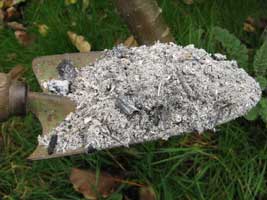Wood Ashes in the Garden
More Information

Turn your wood burning ashes into a useful nutrient for your garden!
Homes with wood stoves and fireplaces for winter heat and backyard fire pits create many tons of ash that can be recycled in our gardens. If you intend to recycle ash from these sources, burn only plain paper or newsprint and clean wood; do not include glossy paper or treated wood. Fall and winter months are the best time to distribute ash in the garden, this way it can settle in to the soil and release its nutrients the following spring.
There are many benefits that come from adding clean burning wood ash in the garden. Ashes contain phosphorous, magnesium, potassium and calcium carbonate, all of which are important in maintaining healthy garden soil. Wood ash has an alkaline pH so is excellent for raising the pH in acid soils. The ash helps deter slugs and a number of other harmful pests. When applied to the soil, it acts much like limestone by raising the pH or alkalinity of the soil. Unlike limestone, wood ash has high water solubility and works quicker to change the soil pH. This may cause a problem in many gardens that tend to have a naturally high soil pH. Wood ashes should not be applied around acid-loving plants, such as azaleas, rhododendrons, and blueberries. Although a soil test is the best way to determine whether wood ashes are needed in your garden soil, an annual application of no more than 20 pounds sprinkled over 1,000 square feet of the lawn or garden in the fall or winter should be safe. In the spring and summer add your clean burning wood ash to the compost pile!

